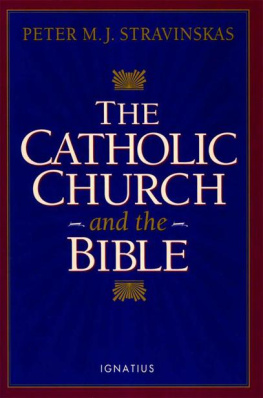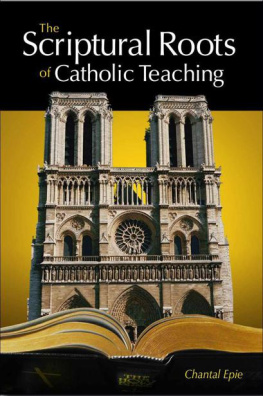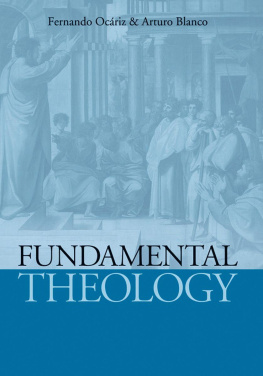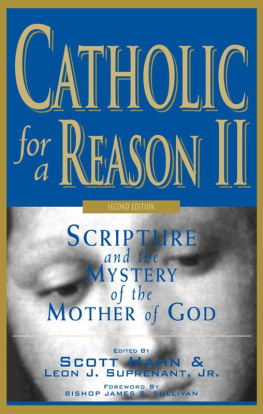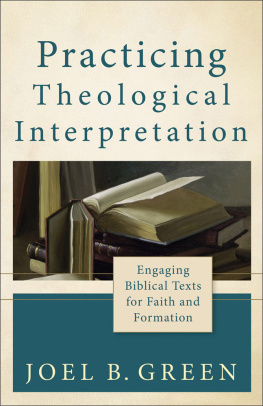
Emmaus Road Publishing
827 North Fourth Street
Steubenville, Ohio 43952
2013 Mark J. Zia, S.T.D.
All rights reserved. Published 2013
Printed in the United States of America
17 16 15 14 13 1 2 3 4 5 6
Library of Congress Control Number: 2013936192
ISBN: 978-1-937155-98-8
Unless otherwise marked, Scripture quotations are from Revised Standard Version of the BibleSecond Catholic Edition (Ignatius Edition) Copyright 2006 National Councilof the Churches of Christ in the United States of America.
Used by permission. All rights reserved.
Excerpts from the English translation of the Catechism of the Catholic Church for the United States of America copyright 1994, United States Catholic Conference, Inc.Libreria Editrice Vaticana.
English translation of the Catechism of the Catholic Church:Modifications from the Editio Typica copyright 1997, United States Catholic Conference, Inc.Libreria Editrice Vaticana.
Noted as CCC in the text.
Cover design and layout by: Theresa Westling
Cover images: The Last Supper, Lorenzo Monaco (circa 1370-1425) / Wikimedia Commons
The Four Evangelists, artist unknown (1425-1430) / Wikimedia Commons
Nihil Obstat: Leon Suprenant Censor Librorum
Imprimatur: Most Reverend Joseph F. Naumann, Archbishop of Kansas City in Kansas
August 24, 2012
The Nihil Obstat and Imprimatur are official declarations that a book or pamphlet is free of doctrinal or moral error. No implication is contained therein that those who have granted the Nihil Obstat and Imprimatur agree with the contents, opinions, or statements expressed.
In memory of my infant son,
Mark Michael Zia,
who has gone to his eternal reward with the Lord.
Acknowledgments
I would like to thank several of my colleagues in the Theology Department here at Benedictine College for graciously reviewing the various chapters of this work and offering constructive criticism: Dr. Benjamin (Jamie) Blosser, Dr. John Rziha, Dr. Matthew Ramage, Dr. Richard White, Dr. Andy Swafford, and Fr. Denis Meade, O.S.B. I also wish to thank and acknowledge my assistant, Ms. Monica Kopp, for her invaluable assistance with proofreading the entirety of this manuscript, and Mr. Leon Suprenant for his editorial suggestions. Any shortcomings of this book are entirely my own.
TABLE OF CONTENTS

The Faith Understood: An Introduction to Catholic Theology provides the reader with a solid introduction to the most significant creedal teachings of the Catholic Church. It is the first of a possible series of projected texts centered upon a better understanding of Catholicism in its various aspects, and a humble contribution to the Year of Faith announced by Pope Benedict XVI, beginning October 11, 2012.
For Catholics, this book will help clarify and explain central teachings of a faith that many proclaim, but relatively few sufficiently understand. For non-Catholics, this book will present what Catholics truly believe, thereby providing a platform for ecumenical discussions. This book is written in a style that constantly references authoritative sources for Catholics. The copious footnotes focus upon the Bible, the Catechism of the Catholic Church (hereafter referred to as the Catechism), the documents of the Second Vatican Council, and many other magisterial documents in order to direct the motivated reader to the sources for a more in-depth treatment of the issues presented. Indeed such a focus on both the Catechism and Vatican II is timely, since the opening of the Year of Faith on October 11th falls on the 50th anniversary of the convocation of Vatican II, as well as the 20th anniversary of the promulgation of the Catechism.
Largely structured around the first pillar (creed) of the Catechism, this book is not meant to be a substitute for the Catechism itself, but an aid to understand the richness and reasonability of the Churchs major teachings. Academic, but not difficult to read, this book is ideal for college students, seminarians, adult faith formation programs, high school teachers, and anyone else who is motivated to learn more about the Catholic faith in complete faithfulness to the Churchs Magisterium.
The chapters of this book are meant to be read in order, since earlier chapters will explain terms and concepts used in later chapters, thereby gradually building up the body of knowledge gained by the reader.

Overview
The term theology comes from two Greek words, theos and logos. Whereas the term theos simply means God, the term logos is a bit more complex. Originally part of the philosophical heritage of classical Greek, logos in its basic sense may refer to a word, a deed, or a thought, but it also refers to a principle of reason, of intelligibility. The discipline of theology, therefore, is a reasoning process about God and all He has made known to us through a process called divine Revelation. Divine Revelation may be defined as the self-disclosure of God and His plan for our salvation. Note that divine Revelation does not simply concern God and what He has manifested to us, but it also highlights His plan for each of us. This two-fold focus of divine Revelation reflects the fact that God is not interested in simply telling us all about Himself, but He constantly invites us all to enter into living communion with Him, to share in His very Trinitarian life. Thus, the Catechism tells us:
The Fathers of the Church distinguish between theology (theologia) and economy (oikonomia). Theology refers to the mystery of Gods inmost life within the Blessed Trinity and economy to all the works by which God reveals himself and communicates his life. Through the oikonomia the theologia is revealed to us; but conversely, the theologia illuminates the whole oikonomia. Gods works reveal who he is in himself; the mystery of his inmost being enlightens our understanding of all his works. So it is, analogously, among human persons. A person discloses himself in his actions, and the better we know a person, the better we understand his actions. (236)
If I take a look at the fruit trees in my neighborhood, I immediately observe that many are strong with beautiful green leaves, yet I also notice a few with withering brown leaves and flimsy branches. The healthy trees will bear succulent fruit, and by the same token, the sickly trees will bear diseased fruit at best. Jesus himself uses this observation in his own teaching, So, every sound tree bears good fruit, but the bad tree bears evil fruit. A sound tree cannot bear evil fruit, nor can a bad tree bear good fruit (Mt. 7: 1718). By analogy, just as the tree is known to be good by the good fruit it produces, so can God and His goodness be known through the works of his hand that are evident in the world around us. In this way, the oikonomia (the economy, which refers to all the wonderful things God has created) bears witness to the theologia (the mystery of God in Himself), just as the truth of Gods Being (the theologia) already tells us in advance of the wonderful masterpieces of creation (the oikonomia) we can expect from Him.
The Bible
The Second Vatican Council teaches that the study of the sacred page should be the very soul of sacred theology and it should be no surprise to any Christian that the Bible is a primary source for us to study theology. Defined as the inspired and inerrant written word of God, the Bible consists of Gods self-communication to us for the sake of our salvation. Much more will be said about the importance of the Bible in later chapters of this book dedicated specifically to an understanding of the Bible.







